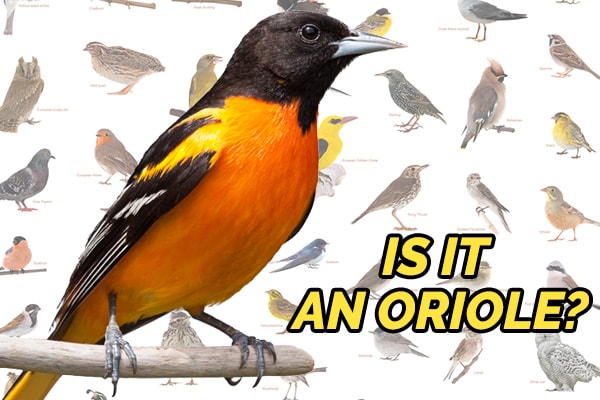Contents
Orioles are probably one of the most loved birds that visit the backyard. They are known for their orange and black plumage and their beautiful singing voices.
However, if you’re not a bird expert…
You might find a lot of birds that look like orioles. After all, although the avian kingdom is large, certain bird species can be related to orioles. This includes:
- Meadowlarks
- Blackbirds
- Bobolinks
- Grackles
So, before you assume that you’ve seen an oriole, you might want to look at some identifying features such as the size, marks, tune, etc., as you might be looking at another bird.
In this article, we will talk about the 12 bird species that look like Orioles and how you can differentiate them.
If you want to become a bird expert on orioles and species that look like it, read on…
What are Orioles?
Orioles are widespread throughout America.
They are characterized by their famous orange and black plumage, with their orange feathers ranging from burnt and bright orange to yellow. Males are more vibrant than females, so you’ll find female Orioles with grey and olive plumage most of the time.
These birds are also famous for the sweet tune they sing whenever they’re around. They are also known as excellent nest makers, with their nests always appearing as masterpieces.
There are more than 30 species of Orioles in America, but only nine popular species are commonly found in your backyard, including the popular Baltimore Oriole, the state bird of Maryland.
Birds That Resemble Orioles
As Orioles are closely related to the Blackbird Family, many birds look like it. And today, we’ll discuss the most popular of those birds:
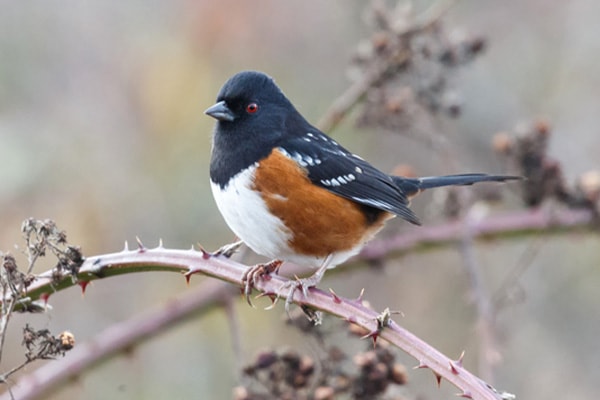
Spotted Towhee
- Common Name: Spotted Towhee
- Scientific Name: Pipilo maculatus
- Length: 6.7 – 8.3 inches
- Weight: 1.2 – 1.7 ounces
- Wingspan: 11.0 inches
Spotted Towhee is a large sparrow that features a thick, pointy, short bill, short neck, and chunky body.
These birds look very similar to Orioles because of their orange and black plumage. However, you would quickly notice their difference because Orioles have longer bills and longer necks.
To easily identify Spotted Towhees, the first you’ll look at is their color pattern. Male birds have jet-black upper parts, from their head to their throat, wings, and tail. And as their name implies, their back, wings, and tail have bright white spots.
Their side parts are a rusty orange, and their belly part is white. And when they’re on flight, you’ll easily notice that the corners at the back of their tail are white.
On the other hand, female birds are paler, with their head, throat, and back areas brown. But, you’ll also find the same black spots on their wings and tails.
These birds are resident to short-distance migratory birds. They are generally found in the western parts of the US, and some parts of Canada, Alaska, and Mexico. They often stay in dry thickets, forest edges, old fields, shrubby backyards, and other areas with many shrubs or leaf litter.
Interesting Facts About Spotted Towhee
- Male towhees have been recorded to spend 70-90 percent of their mornings just singing.
- Spotted Towhees opt to live in drier habitats than Eastern Towhees.
- Their white spots are believed to help them blend into the sun.
- The oldest recorded Spotted Towhee was 11 years old.

Eastern Towhee
- Common Name: Eastern Towhee
- Scientific Name: Pipilo erythrophthalmus
- Length: 6.8 – 8.2 inches
- Weight: 1.1 – 1.8 ounces
- Wingspan: 7.9 – 11.0 inches
Eastern Towhee is a large sparrow that features a large, thick, triangular bill that helps them crack seeds. And like the Spotted Towhee, they have a chunky body and long, rounded tail.
They are also similar to Orioles because of the similar orange and black plumage.
Eastern Towhees feature jet black feathers on their heads, throats, back, wings, and tails, and warm, rusty colors on their sides and white bellies, like the Spotted Towhee. The only difference, they have white marks on their wings and not spots.
You’ll also notice that Eastern Towhees have a feathery head.
Female birds have the same pattern as the males, but they are more brownish stead of a black and orange plumage.
These birds are short-distance migratory birds and are generally found in the eastern parts of the US. They also love staying in forest edges, overgrown woodlands, thickets, and shrubby backyards.
Interesting Facts About Eastern Towhees
- They are common victims of the parasitic Brown-headed Cowbird.
- Eastern Towhees are solitary birds.
- The oldest recorded Eastern Towhee was at least 12 years and three months old.

American Robin
- Common Name: American Robin
- Scientific Name: Turdus migratorius
- Length: 7.9 – 11.0 inches
- Weight: 2.7 – 3.0 ounces
- Wingspan: 12.2 – 15.8 inches
As one of the most popular bird species, American Robins are generally easy to identify.
They are large-sized songbirds with round bodies, long legs, and long tails. And similar to orioles, these birds feature a gray-brown plumage on their upper body and warm orange feathers on their underparts. Females, on the other hand, have paler plumage than males.
These birds are widespread around North America and are resident to short-distance migratory birds.
American Robins in the US are resident birds, while those who breed in Alaska and Canada fly down south to US or Mexico for winter. You can easily find them anywhere, whether it’s deep in the forests and mountains or near people in lawns, parks, fields, and backyards.
Interesting Facts About American Robin
- American Robins are considered harbingers of spring because they usually arrive in their breeding grounds when spring comes.
- They eat a lot of fruit in fall and winter, sometimes making them intoxicated.
- Their roosts can be huge, sometimes reaching up to quarter-million birds in cold winters.
- The oldest recorded American Robin was 13 years and 11 months old.
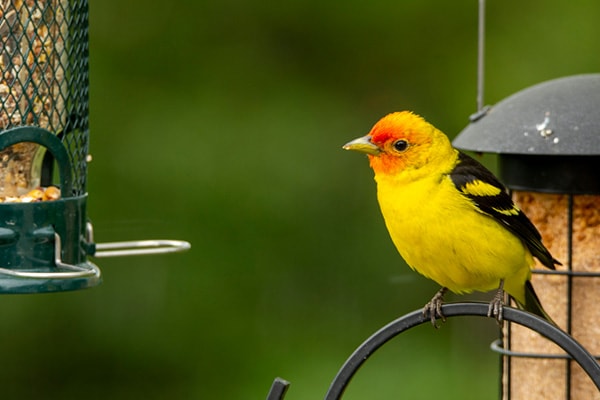
Western Tanager
- Common Name: Western Tanager
- Scientific Name: Piranga ludoviciana
- Length: 6.9 – 7.5 inches
- Weight: 0.8 – 1.3 ounces
Although most orioles feature an orange and black plumage, some feature a yellow and black plumage like the Scott’s and Bullock’s Oriole. And the Western Tanager looks very similar to these birds.
Western Tanagers are medium-sized songbirds whose size is in between a sparrow and a robin. They have short bills with a thick base and have medium-length tails.
Male birds feature a yellow and black plumage, but the biggest distinguishing feature is their flaming orange heads. Their whole bodies are yellow plumage, while their wings and tails are black with white wing bars.
Female birds have yellowish bodies overall and have grayish wings. They’re also missing that flaming red feature that males have.
These birds are long-distance migrants. They generally breed in some parts of Alaska and the western US and spend their winter south in Mexico.
Western Tanagers generally breed in open forests, while they spend more time in pine-oak woodlands and forest edges during winter.
They are also visitors of backyard feeders but only stop by during migration.
Interesting Facts About Western Tanager
- Western Tanagers get their redness from a rare pigment called rhodoxanthin.
- They were hunted down around the turn of the 20th century.
- The oldest recorded Western Tanager lived for six years and 11 months.
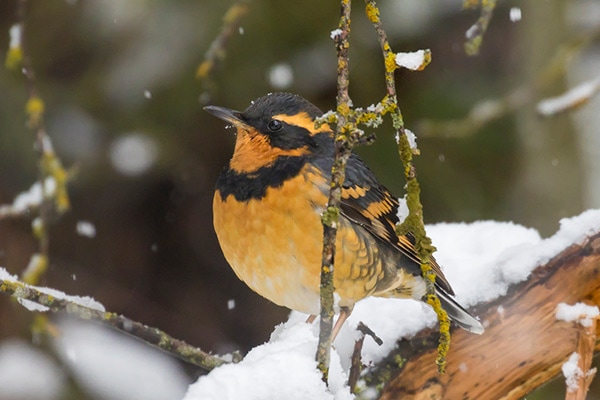
Varied Thrush
- Common Name: Varied Thrush
- Scientific Name: Ixoreus naevius
- Length: 7.5 – 10.2 inches
- Weight: 2.3 – 3.5 ounces
- Wingspan: 13.4 – 15.0 inches
Varied Thrush is a large-sized bird around the size of an American Robin. They have stocky bodies, large and round heads, straight bills, and long legs.
The backs of Varied Thrush are of dark bluish-gray color, while their underparts are of burnt orange plumage. You’ll also find a dark-bluish gray line on their eye area, and there are some burnt orange patches on their wings.
Female birds are always lighter than males and show a gray-brown plumage instead of a bluish-gray.
These birds are short-distance migratory birds and mainly breed in the western side of Alaska. They then fly south for winter in the western parts of the United States.
The Varied Thrush mainly breeds in dark, wet, and mature forests, but in winter, that’s when you’ll find them in areas where there are more people, such as in parks, gardens, backyards, and other areas where fruits and berries are abundant.
Interesting Facts About Varied Thrush
- Varied Thrushes are very aggressive, often dominating sparrows, blackbirds, cowbirds, towhees, and juncos.
- The Varied Thrush population is in steep decline.
- The oldest recorded Varied Thrush lived for four years and nine months.
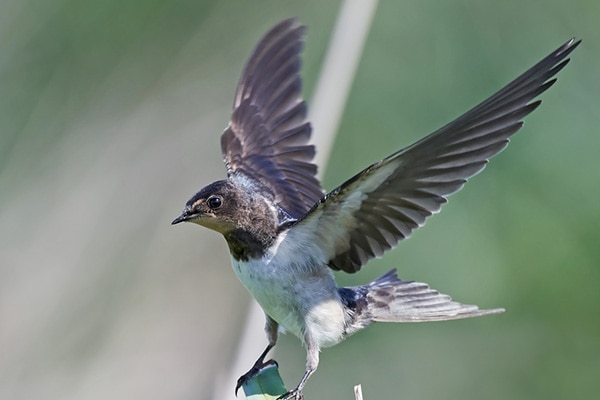
Barn Swallow
- Common Name: Barn Swallow
- Scientific Name: Hirundo rustica
- Length: 5.9 – 7.5 inches
- Weight: 0.6 – 0.7 ounces
- Wingspan: 11.4 – 12.6 inches
Barn Swallow is a small and beautiful songbird. They have slightly flattened heads, no neck, broad shoulders, and long, pointed wings.
They are characterized by a shiny dark blue and orange plumage. Their upper parts are covered with glossy, dark blue plumage from their head, wings, to tail, while their underparts showcase that rusty brown color.
Barn Swallows are long-distance migratory birds that breed all around Alaska, Canada, and the United States. And when the weather gets colder, they fly south to Mexico. You’ll usually find them in open areas, including parks, fields, beaches, and near bodies of water like lakes, ponds, and the sea.
Interesting Facts About Barn Swallow
- The Barn Swallow is the most abundant swallow species in the world.
- Parents often get help from other birds to feed their young.
- According to a legend, Barn Swallows got their forked tails because they were stealing fire from the gods as gifts to people.
- The oldest recorded Barn Swallow has lived for ten years.
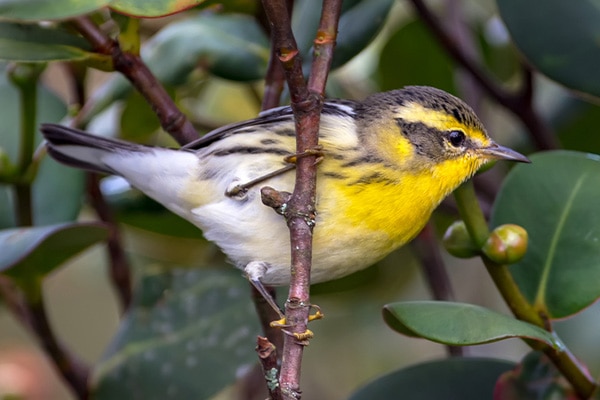
Blackburnian Warbler
- Common Name: Blackburnian Warbler
- Scientific Name: Setophaga fusca
- Length: 4.3 – 4.7 inches
- Weight: 0.3 – 0.4 ounces
- Wingspan: 7.9 9.1 inches
Blackburnian Warbler is a small-sized bird with a chunky body. It also features a short, thin, pointed bill, and a medium-length tail.
During the summer season, a breeding male Blackburnian Warbler is easily identified thanks to its bright orange and black feathers. Their faces and throats are covered with that bright orange plumage, their bellies are white, and the upper parts of their body are black with white stripes. You’ll also find that they have a black line on their eye area.
These birds are medium-distance migratory birds, mainly breeding in the lower eastern parts of Canada and flying down to South America for winter. You’ll often find these birds in mature coniferous and mixed coniferous-deciduous forests.
Interesting Facts About Blackburnian Warbler
- No other warbler has an orange throat.
- Blackburnian Warblers are strong fliers that travel between North and South America twice a year.
- The oldest recorded Blackburnian Warbler has lived for eight years and two months.
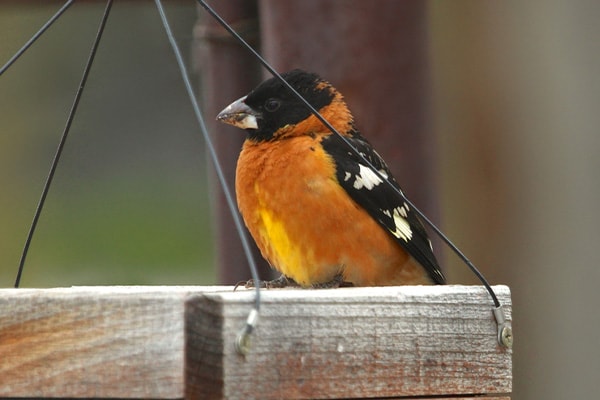
Black-headed Grosbeak
- Common Name: Black-headed Grosbeak
- Scientific Name: Pheucticus melanocephalus
- Length: 7.1 – 7.5 inches
- Weight: 1.2 – 1.7 ounces
- Wingspan: 12.6 inches
From afar, Black-headed Grosbeaks can easily be mistaken for orioles. But as you walk closer, the most distinguishable feature is their large-sized bills, conical bills. And this is very far from the pointy bills that orioles have.
These birds have robin-sized bodies, with large heads, short necks, and short tails.
Like the many birds on this list, Black-headed Grosbeaks feature an orange and black plumage. Their bodies are covered with rich-cinnamon feathers, their heads, wings, and tail areas are black, and they are noticeable white bars on their wings and tails.
Female birds, on the other hand, are brown throughout with a hint of orange on the breast and the sides.
Black-headed Grosbeaks are medium to long-distance migratory birds. They breed in the western part of the United States and travel south to Mexico for winter. You’ll find them in habitats where plants like berries are abundant and there’s access to water.
Interesting Facts About Black-headed Grosbeaks
- Black-headed Grosbeaks are shy birds despite their vibrant color.
- They are one of the few birds who prey on monarch butterflies and not get poisoned.
- They are very loud singers.
- The oldest recorded Black-headed Grosbeaks lived for 11 years and 11 months.

Evening Grosbeak
- Common Name: Evening Grosbeak
- Scientific Name: Coccothraustes vespertinus
- Length: 6.3 – 7.1 inches
- Weight: 1.9 – 2.6 ounces
- Wingspan: 11.8 – 14.2 inches
The Evening Grosbeak is another bird species that adds a splash of color to winter bird feeders.
Male Evening Grosbeaks feature a yellow and black plumage, with white patching on their wings. There is a yellow line right above their eyes, the top of their heads is colored black, and their neck and throat areas are grayish-brown.
Female birds, on the other hand, don’t show a bit of that yellow color. Instead, their bodies are primarily gray, their wings are black with white patches, and they have a hint of green color on their necks.
These birds are found throughout the US. They are irregular migrants, meaning they move depending on the abundance of food resources, weather, and more.
These birds mainly breed in the lower parts of Alaska and Canada and fly to the US for winter. You’ll also find them breeding mainly in mature and second-growth coniferous forests. In winter, they mainly live in coniferous forests, deciduous forests, and urban or suburban areas.
Interesting Facts About Evening Grosbeak
- Evening Grosbeaks may be the only songbird that doesn’t have a song.
- Their large bills make it easier for them to crush very large seeds.
- The oldest recorded Evening Grosbeak lived for 16 years and three months.
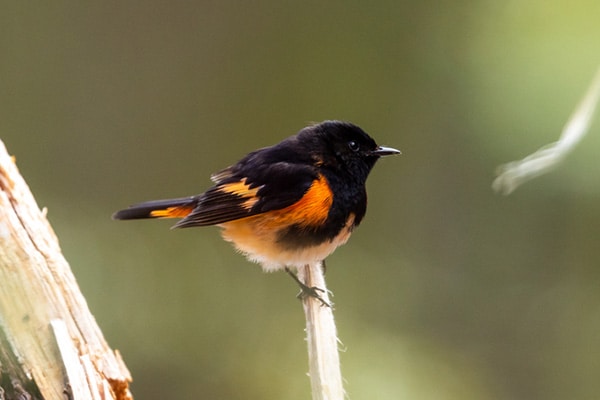
American Redstart
- Common Name: American Redstart
- Scientific Name: Setophaga ruticilla
- Length: 4.3 – 5.1 inches
- Weight: 0.2 – 0.3 ounces
- Wingspan: 6.3 – 7.5 inches
American Redstarts are small birds with wide, flat bills, chunky bodies, and long tails. And like most birds in this list, they have black and orange plumage.
They have black feathers on their heads, back, and throat, white bellies, orange sides, and some orange patches on their wings. Female birds appear more yellowish with gray heads, olive back and wings, and dark-grey tails.
These birds are long-distance migratory birds that breed in Alaska, Canada, and the United States, and spend the winter season down to South America. You’ll find them often in moist, deciduous woodlands where there are lots of shrubs.
Interesting Facts About American Redstart
- American Redstart sometimes has two mates at the same time.
- The oldest American Redstart has lived for ten years.
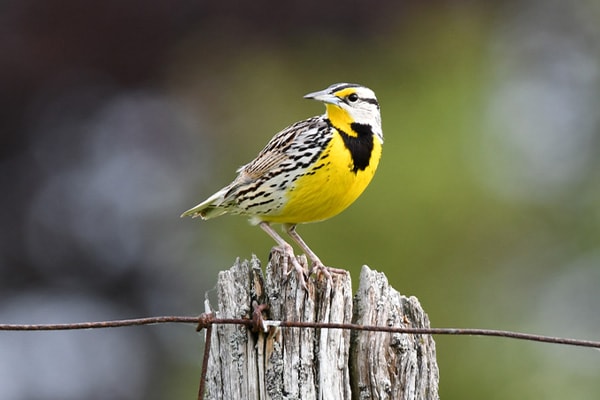
Eastern Meadowlark
- Common Name: Eastern meadowlark
- Scientific Name: Sturnella magna
- Length: 7.5 – 10.2 inches
- Weight: 3.5 – 5.3 ounces
- Wingspan: 13.8 – 15.8 inches
Eastern Meadowlarks are medium-sized songbirds that are slightly larger than American Robins. They have chunky bodies, short tails, rounded wings, and spear-shaped bills.
These birds look very similar to orioles, thanks to their yellow and dark plumage. They feature a brown back with black markings, yellow underparts, a black v-shaped mark across their chest, and a solid black line at the back of their eyes.
And while most female birds have lighter plumage than males, male and female Evening Grosbeaks have the same plumage all year round.
These birds are resident and short-distance migratory birds. Their breeding areas are mainly located in the southeastern parts of Canada down to the northeastern parts of the United States and will move south for winter.
Most populations, however, stay in one place all year round. These birds are mainly found in the eastern parts of the United States, some parts of Mexico, and northern areas of South America.
You’ll find most of their populations in grassy areas such as agricultural fields, prairies, pastures, and more.
Interesting Facts About American Robin
- Despite their name, the meadowlark does not belong in the lark family, but instead, a member of the blackbird family.
- Male birds generally have two mates every breeding season.
- The bird can sing more than 100 different patterns of songs.
- The oldest Western Meadowlark lived for eight years and eight months.
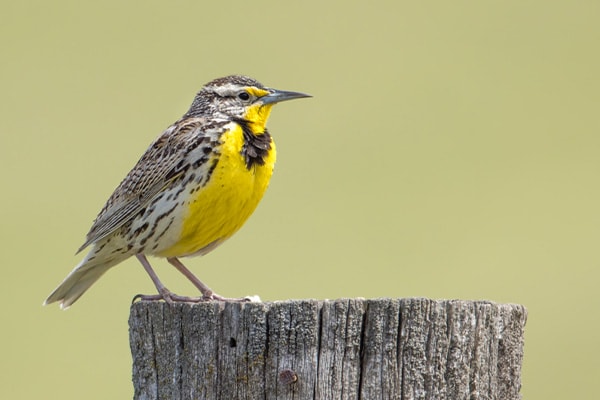
Western Meadowlark
- Common Name: Western Meadowlark
- Scientific Name: Sturnella neglecta
- Length: 6.3 – 10.2 inches
- Weight: 3.1 – 4.1 ounces
- Wingspan: 16.1 inches
Western Meadowlarks look very similar to the Eastern Meadowlarks, from their colors to their patterns. They both feature a yellow and dark plumage, their upper parts are covered with brown spots, the underparts are yellow, and they feature a black V across their chest.
The only difference between the two is that Western Meadowlarks are paler or lighter in color than the Eastern ones. They also grow larger, particularly their wingspan.
As their name implies, these birds are found in the western parts of the US, with some populations breeding in southwestern parts of Alaska and Canada. And unlike Eastern Meadowlarks, you won’t find any of these birds in South America.
You can also find this species in grassy areas, such as prairies, agricultural fields, and prairies.
Interesting Facts About Western Meadowlark
- The Western Meadowlark is the state bird for six states: Kansas, Nebraska, Montana, North Dakota, Oregon, and Wyoming.
- Male Western Meadowlarks have two mates in every breeding season.
- They were given the species name “neglecta” because most explorers seem to have neglected or overlooked this bird.
- The oldest recorded Western Meadowlark lived for six years and six months.
Final Thoughts On Birds That Look Like Orioles
Identifying bird species can be very hard. There will be more than one species that has that blue color, red color, and for orioles, orange and black color.
So, pay attention to those very few markings or details like spots, patches, colors, and more. These are what will help you identify one bird species from another.

